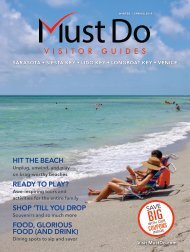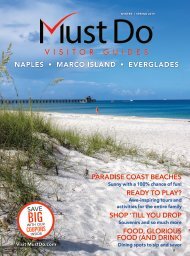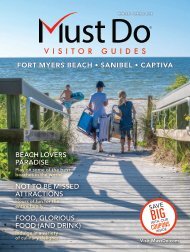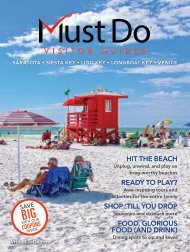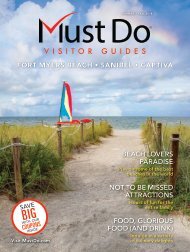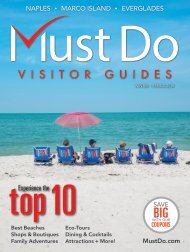Must Do Sarasota Visitor Guide Winter/Spring 2018
Must Do Visitor Guides we believe the best experiences in life are better when shared, and so we do. Inside this Sarasota Winter/Spring 2018 issue, you will find over one hundred well-researched and carefully curated standout things to do so you can make the most of your visit. Everything from major attractions to awe-inspiring tours or family activities conveniently arranged in our Top 10 directories. Our dining and nightlife recommendations take the guesswork out of where to find a great meal or drink. You can make your experience here even more spectacular with our valuable deals and savings.
Must Do Visitor Guides we believe the best experiences in life are better when shared, and so we do. Inside this Sarasota Winter/Spring 2018 issue, you will find over one hundred well-researched and carefully curated standout things to do so you can make the most of your visit. Everything from major attractions to awe-inspiring tours or family activities conveniently arranged in our Top 10 directories. Our dining and nightlife recommendations take the guesswork out of where to find a great meal or drink. You can make your experience here even more spectacular with our valuable deals and savings.
You also want an ePaper? Increase the reach of your titles
YUMPU automatically turns print PDFs into web optimized ePapers that Google loves.
Florida’s<br />
Unique Wildlife<br />
Many endangered and protected animal species reside in Southwest<br />
Florida’s unique landscape including the American alligator, Florida<br />
panther, black bear, West Indian manatee, bottlenose dolphin, burrowing<br />
owl, gopher tortoise, and countless more rare birds. Some of the best<br />
places to see these creatures in their native habitats are right here in<br />
<strong>Sarasota</strong> County and the Everglades.<br />
Everglades National Park<br />
With over 2,500 square miles of swamp and sawgrass marsh, Everglades<br />
National Park’s unique ecosystem provides a one-of-a-kind habitat for<br />
snakes, alligator, crocodile, wading birds, and more. An airboat tour<br />
through this magnificent area to view its abundant wildlife is not to<br />
be missed.<br />
Florida’s state animal is the Florida panther, a subspecies of cougar. This large, long-tailed, pale brown cat grows to six feet<br />
or more and with less than 100-180 remaining in Florida; it is one of the most endangered mammals in the world. Its habitat<br />
is usually the same as the mainstay of its diet, the white-tailed deer and wild boar. When deer and hog are not available,<br />
panthers will eat other small animals such as raccoons or armadillos. Many of Florida’s remaining panthers live in or near<br />
Everglades National Park and Big Cypress National Preserve. No need to be nervous about encountering these elusive cats,<br />
the closest you’re most likely to get during your visit is spotting a panther crossing sign – and if you do, slow down and keep<br />
a watchful eye. Since 2014, Florida has had a record number of Florida panther deaths, the majority due to road collisions.<br />
Southwest Florida Marine Life<br />
The Gulf waters around Southwest Florida are teaming with<br />
amazing marine life. Two of the most popular residents are<br />
bottlenose dolphins and the West Indian manatee. A cruise<br />
or kayak trip is a great way to view dolphins or manatees.<br />
<strong>Do</strong>lphins love to leap and play in the bow waves or chase<br />
the wake of boats. You can often see manatees grazing on<br />
sea grasses in shallow waters of the areas mangrove-laden<br />
estuaries. Sometimes when manatees see kayaks on the<br />
surface, they will come in close to get a good look. Local<br />
guides will give you the best chance of catching a glimpse<br />
of a manatee in the wild.<br />
SHUTTERSTOCK<br />
than you want to be stung! What should you do if you happen to step<br />
on a stingray and get stung? Head to the lifeguard stand when possible.<br />
If there isn’t one available try a nearby home, hotel, or restaurant. First<br />
aid for stingray stings involves flushing the wound with fresh water if<br />
possible, and soaking the affected area in hot water (as hot as can be<br />
tolerated without causing burns). Most lifeguard stands have buckets<br />
and hot water on hand for stingray accidents. If the victim shows any<br />
signs of an allergic reaction – DIAL 911.<br />
During the summer months, mother sea turtles emerge from the Gulf<br />
of Mexico during the late night hours. They slowly plow their way<br />
through the sand, hollow out a nest and lay around 100 ping-pong<br />
ball sized eggs. She will cover the eggs to protect and hide them from<br />
harm, and then crawl back out to sea. Each turtle nest will remain<br />
quiet for about two months as the baby turtles grow and mature. Instinct<br />
drives baby turtles to dig out of the sand that has been protecting<br />
them and follow the moonlight reflected on the water that will lead<br />
them to the sea. This event will happen over and over into October until<br />
all of the viable eggs have hatched. <strong>Visitor</strong>s staying in properties on<br />
the beach front should turn outside lights off at night as the light confuses baby turtles. When your day at the beach is over<br />
remember to fill in any holes dug on the beach before you leave, this will ensure that the hatchlings have a clear path through<br />
the sand and help them make it safely to the Gulf waters. Watching sea turtles can be an incredible experience for the whole<br />
family. Following the guidelines above will ensure that many families will enjoy the experience for years to come.<br />
Take advantage of the many knowledgeable guides and eco-tour options the area has to offer to experience Florida’s<br />
wild side.<br />
ONLY A SHORT<br />
DRIVE OFF I-75!<br />
Airboat & Swamp Buggy Tours<br />
Horseback Riding Adventures<br />
ENJOY THE MAJESTIC PEACE RIVER! VISIT OUR COUNTRY STORE & HOLD A BABY GATOR!<br />
NITA ETTINGER<br />
SHUTTERSTOCK<br />
28 WINTER | SPRING <strong>2018</strong> <strong>Must</strong><strong>Do</strong>.com<br />
Stingrays frequently can be found in the warm shallow<br />
waters of the Gulf of Mexico during the months of May<br />
through October. They come close to shore in search of food<br />
and bury themselves in the sand. You don’t want to step on a<br />
stingray – the result could be a painful sting. In order to prevent<br />
this, it is important to do the “Stingray Shuffle” when<br />
entering the water of Southwest Florida’s beaches. By shuffling<br />
your feet across the sandy bottom you can alert the<br />
stingray of your presence, they will uncover themselves and<br />
swim away. Stingrays don’t want to be stepped on anymore<br />
1.863.444.0693<br />
4192 SW Adventure Way Arcadia, FL<br />
www.peacerivercharters.com







